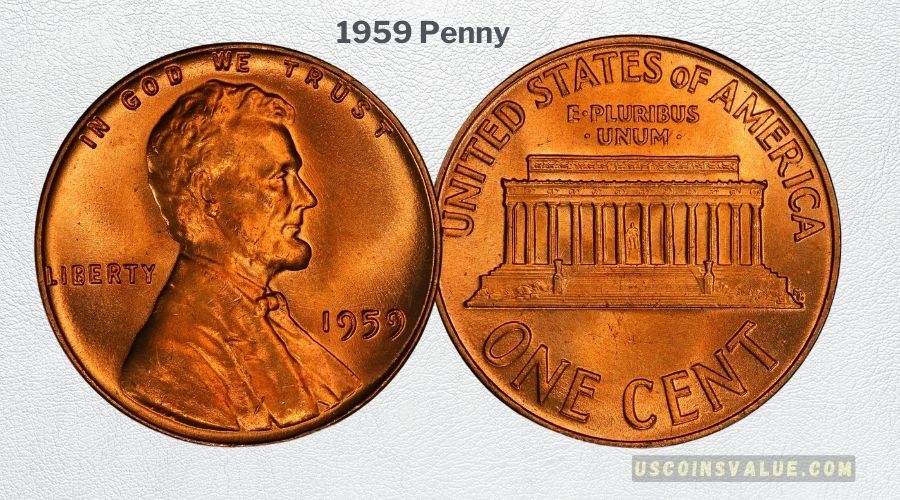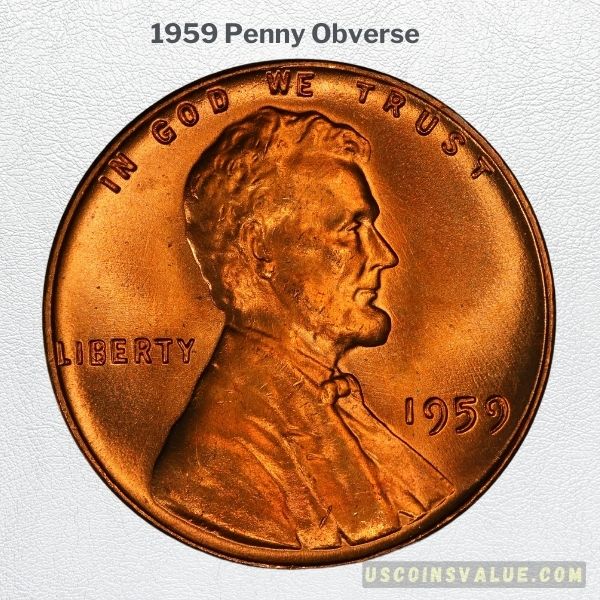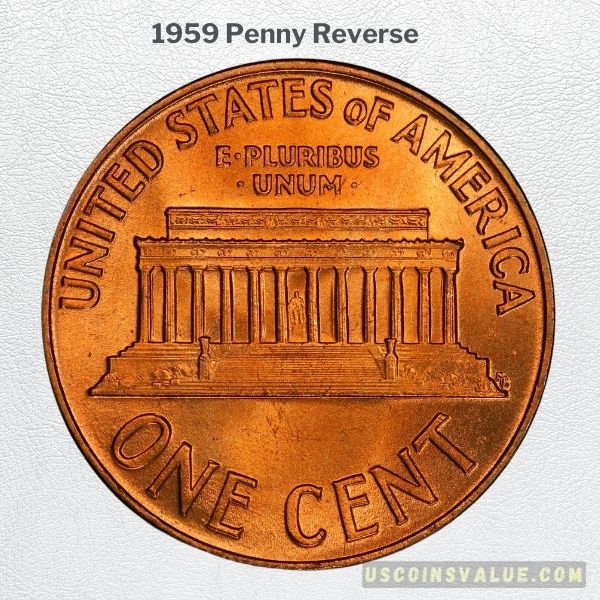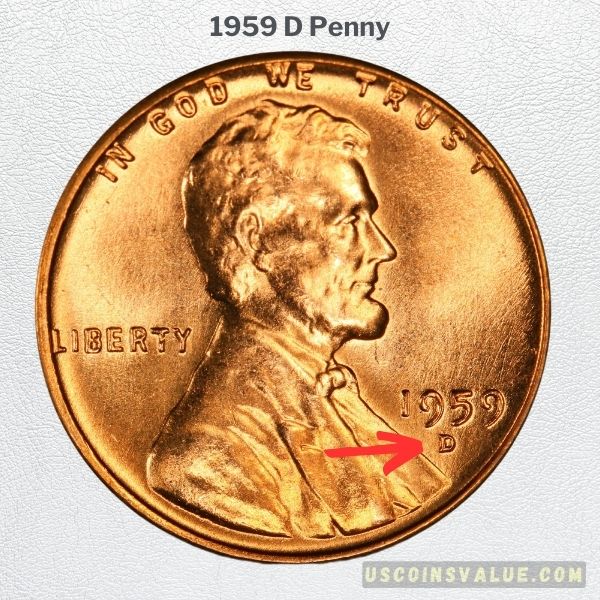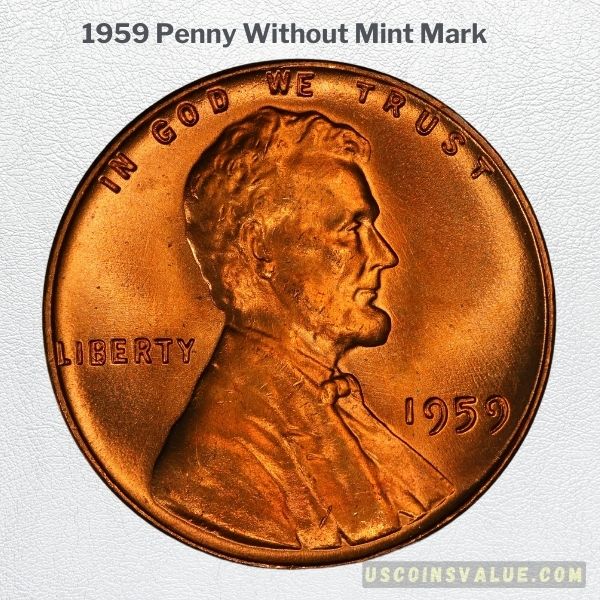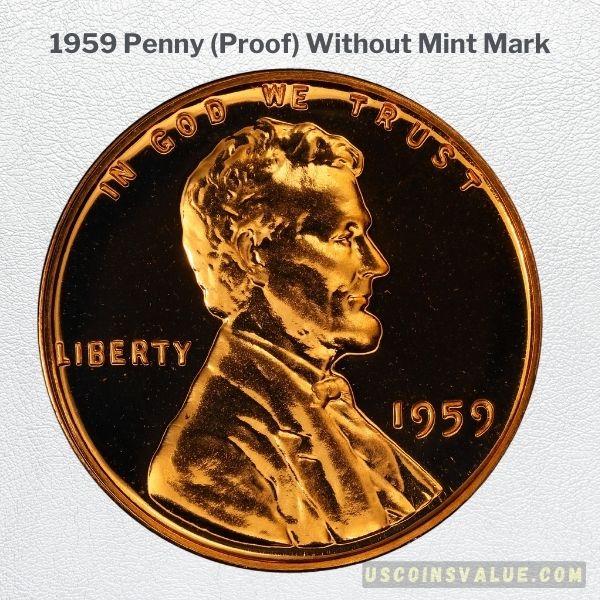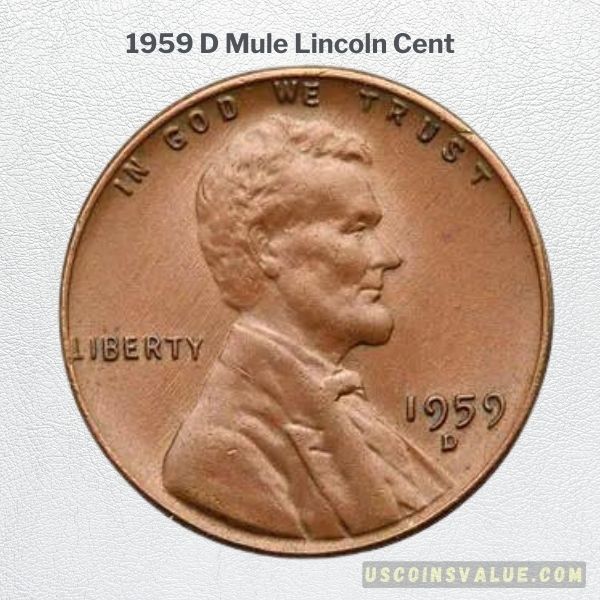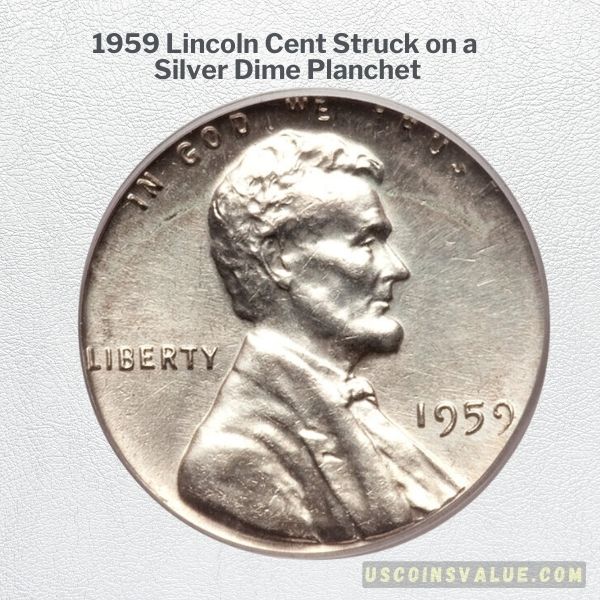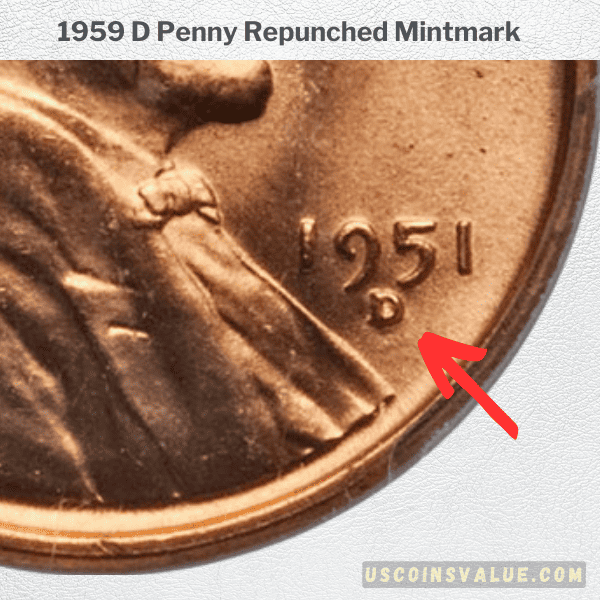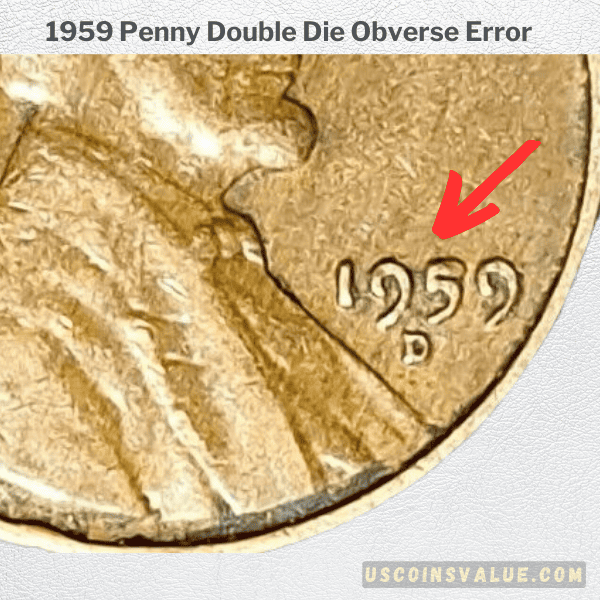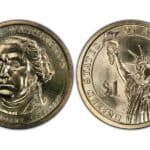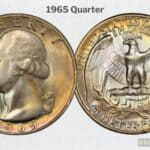The 1959 penny is known for being the first coin to get rid of the Two Stalks Of Wheat design on the coin’s reverse side. Instead, the penny features a Lincoln Memorial design at the back while still maintaining the image of Lincoln on the Obverse.
You should note that a regular circulation 1959 penny is not a rare coin, therefore making its value low. It is valued at less than $1 in its poorest grades and less than $32 in the most common grade conditions.
However, the value can go higher than $2 000 if the coin features a rare error or has a rarer higher grade like MS68.
Read on to dive into the various aspects of the 1959 Lincoln Penny, examining its rarity, history, distinctive features, various varieties, and the factors that contribute to its worth.
History of the 1959 Penny
1959 marked a significant period of transition in the Lincoln Penny series. This was the year when the reverse design, featuring the Lincoln Memorial, replaced the longstanding wheat stalk design.
Lincoln Pennies were first introduced in 1909 and stayed in circulation till 2008, when the Lincoln Bicentennial One Cent Program replaced them. Lincoln Pennies all had one thing in common – the same obverse design as the iconic portrait of Abraham Lincoln.
Between 1909 and 2008, only one change was made: in 1959 the reverse design was changed from that of two wheat stalks to the image of the Lincoln Memorial. This new design was crafted by Frank Gasparro, a sculptor and engraver.
The change marked the 150th anniversary of Lincoln’s birthday.
As a result, the 1959 Lincoln Penny holds a unique place in numismatic history, representing a shift from one era to another.
1959 Penny Features
1959 Penny specifications:
- Composition: 95% Copper and 5% Zinc
- Face value: $0.10 – $0.30
- Weight: 3.11g
- Diameter: 19.00mm
- Thickness: 1.52mm
- Edge: Plain (no reeds)
1959 Penny Varieties
There are only three types of 1959 coins:
- 1959 Penny With Mint Mark (1959-D Penny): 1, 279, 760, 000
- 1959 Penny No Mint Mark (1959-P Penny): 601, 715, 000
- 1959 P Penny (Proof Strike): 1, 149, 291
1959 D Pennies are the most popular, and they were all made in Denver, distinguished from the rest with the ‘D’ mint mark stamped below the date on the obverse.
1959 P pennies were made in Philadelphia and did not feature a mint mark.
Proof strike coins are higher-grade coins made specifically for collectors. They are packaged in mint condition seals and feature a certificate of authentication. Proof coins also have a more reflective and shinier finish.
Obverse and Reverse Design
The obverse (heads) features Lincoln’s image facing the right. Inscriptions include the proclamation:
- IN GOD WE TRUST – above the image of Lincoln
- LIBERTY on the left of the image
- 1959 on the right side of the image depicting the mint year
- ‘D’ Mint Mark or No Mint Mark – appears below the mint year (1959) and indicates the mint’s location: D for Denver. If there is no mint mark under the mint year, then the coin was made in Philadelphia (P), which didn’t include the ‘P’ mint mark.
The reverse depicts the Lincoln Memorial. Reverse inscriptions include:
- UNITED STATES OF AMERICA – curved above the monument
- E PLURIBUS UNUM – A motto that translates to “Out of Many, One” appears inside the concave set over the memorial by the name of the country
- ONE CENT – curved below the monument image
What Makes the 1959 Penny Valuable?
Higher Gradings and Mint Errors are the main reasons why the 1959 pennies are worth so much. Their value will also go up if the pennies are certified and in mint condition.
Other factors that make the coin valuable include:
1. Mint Facility, Mint Mark, No Mint Mark
Mint marks are used to show where the coin was made, thereby indicating which processes were used in its making, judging the quality of the coin & its authenticity, as well as finding out the year of make and hence its rarity.
1959 pennies were produced in Denver and Philadelphia. Denver coins include the 1959 D penny with the mint mark ‘D’, and the rest of the varieties came from Philadelphia.
2. Mint Errors
Coins with mint errors are very valuable since they are unique and not easily available like the standard coins.
Very few 1959 penny errors have been recorded since the coin’s making. The most common one is the 1959-D Repunched Mint Mark Error where the letter ‘D’ is offset twice on some coins during the striking of the Mint Mark.
Other errors include the controversial 1959 Mule Penny Error and the 1959 Penny Double Die Obverse error – more on these errors below.
3. Grading – Coin Condition & Colors
The most valuable 1959 pennies are the coins in very high grades.
The Sheldon grading scale is the industry standard for coin grading, where a coin’s condition is scaled from 1 to 70. This is the scale used by notable grading services like PCGS and the Numismatic Guaranty Company (NGC).
The the scale is divided accordingly, and in the case of the 1959 Penny there are two categories into:
- MS (60 – 70) – stands Mint State and used to show condition of circulation coins from grades 60 to 70.
- PF (60 – 70) – stands for Proof and is used to show grade of Proof coins from grades 60 t0 70.
A scale of 70 (e.g. MS70 or PF70) means that the coin has no post-production imperfections when you magnify the coin at 5x the magnification. A low grade (say MS63 or PF63) shows the coin has average strikes and weaknesses with moderate abrasions and hairlines in varying sizes
MS68 is the highest grade ever recorded in a 1959 penny and only one has ever achieved this rating – the 1959-D MS68RD sold for $6,999 in 2021.
Colors of the coins are used as suffixes to show how well the coin has been protected from external chemical reactions.
Red (RD) means the coin has been sealed and well protected while Brown (BN) means the coin is in the poorest condition and has been highly circulated. Red and Brown (RB) is a mid-condition coin.
4. Demand
Demand will drive the value and price of the 1959 penny. Higher demand for a certain variety means that the value will be added to the price of the coin.
You can look up which 1959 coins are more in demand in coin grading sites like the Professional Coin Grading Services (PCGS).
1959 Penny Value
Below is a summary chart showcasing the common 1959 penny varieties and how much they are valued according to PCGS:
| Grades | 1959 D Penny | 1959 P Penny | 1959 P (Proof) Penny |
| 63 | $4 | $6 | $8 |
| 64 | $10 | $12 | $10 |
| 65 | $16 | $18 | $15 |
| 66 | $32 | $30 | $24 |
| 67 | $315 | $525 | $30 |
| 68 | $9,000 | N/A | $90 |
Note:
- The grades (63 – 68) represents the particular coin’s grading prefix, i.e. MS63-MS68, SP63-SP68 or PF63-PF68 for Proof pennies.
- The N/A in columns without a price guide does not mean the coins are rare. Instead, it shows that there isn’t enough data to publish an average price estimate.
Let’s see how much each 1959 penny is valued:
1. 1959 D Penny Value
It took 68 years for the highest grade of the 1959 D penny to be found. This is the MS68 1959 D Penny which sold on eBay in 2021 for $6,999. Valued at $9,000, this coin is one of a kind since most 1959 D Pennies can only be found in grade MS66 or lower.
Coins from 1959 – 1973 were struck in poor conditions, which was typical for most mints, including the Denver Mint.
Finding these coins in grade MS67 or higher is very challenging. PCGS estimates there are less than 50 coins in this high-grade category. MS67 coins are valued between $75 and $205, MS67+ are between $1,000 and $3,000, while the rarest MS68 can fetch $6,000 or higher.
Grades up to MS66 (low-grade) are very common and easily obtainable. The average price range for MS64 is from $6 – $8, MS65 from $3 – $9, and MS66 from $9 – $90.
Below are the highest historical auction records for the 1959-D pennies:
| Grade | Price | Auction | Sale Date |
| MS68 RD | $6, 999 | eBay | 2021 |
| MS67+ RD | $2, 640 | Heritage Auctions | 2021 |
| MS67+RD | $2, 625 | David Lawrence RC | 2022 |
| MS67+RD | $1,920 | Heritage Auctions | 2023 |
| MS67+RD | $1,920 | Heritage Auctions | 2019 |
2. 1959 Penny Value Without Mint Mark Value
These are the least valuable coins in the entire series, with prices that usually fall below $30 on the regular market.
A few varieties have sold for over $500, but these include rare pennies with MS67 grades and above.
The most common ones you can find in pocket change are the MS66 and below grades which typically cost at most $30 for MS66, $18 for MS65 and $14 for MS64.
Below are the highest historical auction records for the 1959-P pennies:
| Grade | Price | Auction | Sale Date |
| MS67+RD | $5,887 | Heritage Auctions | 2016 |
| MS67+RD | $5, 040 | Heritage auctions | 2019 |
| MS67+RD | $2, 520 | Heritage Auctions | 2020 |
| MS67RD | $2, 350 | Heritage Auctions | 2016 |
| MS67 | $2, 233 | Heritage Auctions | 2014 |
3. 1959 Penny (Proof) Without Mint Mark Value
Proof coins are the highest quality coins that the United States Mint can produce. They are specifically made for commemorative and collector reasons and are not part of the circulated coins in the public domain. They feature zero blemishes due to their high-quality manufacture.
1959 P Proof coins are valuable in their highest grades (PR69 and above). They are evaluated at less than $100, even at PR68 grades.
However, there are unique colors like Red (RD), Cameo (CAM), and Deep Cameo (DCAM) that have sold for over $4, 000.
Below are the highest historical auction records for the 1959-P (Proof) pennies:
| Grade | Price | Auction | Sale Date |
| PR69 | $20, 700 | Heritage Auctions | 2004 |
| PR69 | $4, 313 | Heritage Auctions | 2009 |
| PR65 | $2, 530 | Heritage Auctions | 2006 |
| PR69CAM | $2,400 | Heritage Auctions | 2018 |
| PR68 | $2, 070 | Heritage Auctions | 2004 |
1959 Penny Errors
Below is the short 1959 penny error list showcasing the rarest major errors with descriptions:
1. 1959-D Mule Lincoln Cent
- Mint Error: Mule Error
- Mint: ‘D’ – Denver
- Grade: N/A
- Auction Record: $48, 300 in 2003 at Goldberg Auctions
A mule is a term used in the numismatic industry to refer to a coin with a reverse and obverse sides that belong to different coins.
In this case, the 1959-D Mule Penny is a Lincoln Penny from the Denver Mint that features an obverse side with the Lincoln Image while the reverse features a wheat head design rather than the Lincoln Memorial Image design that has been used in all the 1959-Later coins.
The wheat reverse was last used in 1958 coins. According to the description, the coin was produced by mistake when the Denver mint used the previous year’s die on the reverse instead of the updated 1959 die.
The coin sold at the Goldberg Auction in 2003 for $48,300 and again in 2010 for $31, 050. It was later listed for the 2019 Goldenberg Pre-Long Beach Expo Auction, where it was estimated at a $50,000 valuation.
According to the auction description, the Denver Mint mistake is estimated to have produced about 2,000 Lincoln Pennies with this error in 1959.
However, the controversy of the coin comes in due to the fact that only one of these coins has ever been found.
Denver mints use coin presses which move at rapid speeds and strike more than one coin at a time. That means, if the error was genuine, it would have most likely created more than one coin, and some of them would have been found by now since it has been 50-plus years.
The only 1959-D Mule penny in existence was found by a retired police officer, Leon Baller, in 1986. Baller sent the coin to the U.S. Treasury for authentication and the Department of Treasury authenticated it as genuine. The coin was later sold by Baller.
In 2002 it was further resubmitted to the Treasury for a more in-depth authentication which also proved the coin was a genuine one. The reason for reauthentication due to the fact that the first inspector of the coin was a currency expert and not a coin expert.
Many other grading companies like PCGS took turns inspecting the coin and did not have enough reason to grade it or authenticate it as genuine. It has long been suspected that it was a forgery made using a spark erosion process used in making fake coins.
Due to all of these speculations, the latest 2010 Goldberg Auction sale description of the coin stated, “This property is not guaranteed to be authentic, and is marketable as it is, cannot be returned.”
It is crucial to understand that the 1959 Mule penny may not be a genuine coin. However, it is a controversial piece that has attracted many collectors. Its uniqueness and history make it one of a kind and that is bound to increase its value.
2. 1959 Lincoln Cent Struck on a Silver Dime Planchet
- Mint Error: 1959 Penny Struck on a Silver Dime Planchet – Wrong Planchet error
- Mint: Philadelphia and Denver
- Grade: MS61
- Auction Record: $1, 057.50 at Heritage auctions in 2013
This is a mint error where the wrong planchet is used to make a 1959 coin.
Copper was the primary metal used in the cent in 1959 while silver was the planchet used in the making of the dime. In this error, the silver dime planchet was wrongly used instead to make this coin resulting in this super rare silver-plated 1959 Lincoln cent.
The mass of a coin with this error is about 2.5 grams. This is a good way to know if the error is legitimate of fake since 2.5g is the weight of a silver dime.
The coins have sold for $1, 020 and $1, 057 for the P variety as well as $1, 570 for the D variety.
Other Wrong Planchet errors include the 1959 Lincoln Cent Struck on a Split Planchet on sale for $98.
4. 1959-D Penny Repunched Mintmark
- Mint Error: ‘D’ mint mark is repunched
- Mint: Denver
- Common Grades: MS65 and MS64
- Price Range: $50 – $200
- Auction Record: $200 in 2018 on eBay
Repunched error is one that occurred on the Denver mint coins in 1959. It is a common error compared to the first two super rare errors.
The error happens when the mint mark ‘D’ in the 1959-D pennies were struck twice creating a heavily dented ‘D’ mark due to repunching.
MS64RD is on average $50, MS65RD is about $100, and MS66RD for more than $140.
5. 1959 Penny Double Die Obverse Error
- Mint Error: Double Die Obverse – Doubling on ‘LIBERTY’ and ‘1959’
- Mint: Philadelphia
- Mintage: 609, 715, 000
- Common Grades: MS64 and MS65
- Auction Record: $823 – MS66RD in 2016
Double Die Obverse error is an error that occurs when the coin die used in production is not manufactured correctly. The improperly manufactured coin die has two images instead of one, and therefore, when it strikes the coin, two overlapping images are created on the coin.
The two images can overlap closely undistinguished (partially doubled image) on top of one another, or they can overlap in such a way that you can obviously spot them apart (fully doubled image).
In 1959 DDO varieties with this error were not as obvious as the 1955 doubled die error that sparked the beginning of the era of collecting Error Coins.
Here, the error is spotted on the inscriptions “LIBERTY” and ‘1959’. The indentation of the two inscriptions is heavier and broader than on standard coins.
Despite being a more prevalent error, a good grade of a DDO 1959 Penny can fetch you above $100 in MS64, $200 in MS65, and above $700 in MS66.
Final Thoughts
The most valuable 1959 coins are those that are graded above MS67, including MS67+ and MS68. These are very rare coins since the production processes used between 1959 and 1973 were poor, making it harder to create high-quality coins.
As much as mint errors make these pennies valuable, too, your time will be better spent looking for high-grade coins instead since they bear the biggest potential.

